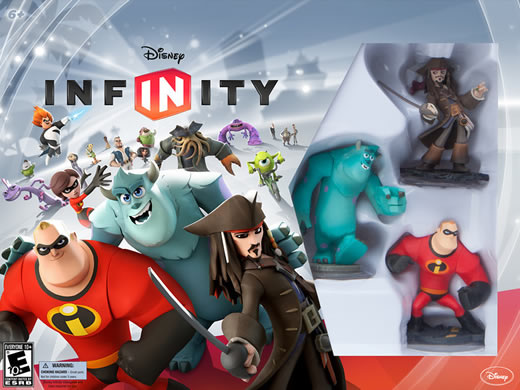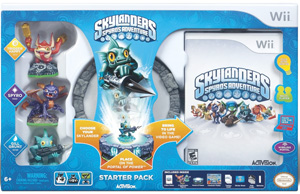Disney Infinity: A Low-Risk Revolution [Part One]
 Writing about Disney Infinity, the latest multi-platform effort from the company’s Interactive division, Salon’s Sarah Kessler claims “Disney has treated its video games like accessories for a long time” and “most [games] have been treated like character lunch boxes and developed on short deadlines in order to match movie release dates,” extending a long line of discourse lamenting the poor quality of licensed video games. She presents Disney Infinity as the antidote, “a dramatic shift in the way Disney’s executives think about gaming”: It has a big budget, a long development period, and the cross-platform integration necessary in a contemporary, digital moment.
Writing about Disney Infinity, the latest multi-platform effort from the company’s Interactive division, Salon’s Sarah Kessler claims “Disney has treated its video games like accessories for a long time” and “most [games] have been treated like character lunch boxes and developed on short deadlines in order to match movie release dates,” extending a long line of discourse lamenting the poor quality of licensed video games. She presents Disney Infinity as the antidote, “a dramatic shift in the way Disney’s executives think about gaming”: It has a big budget, a long development period, and the cross-platform integration necessary in a contemporary, digital moment.
Kessler is not the only one to position Disney Infinity as a bold shift for Disney in the gaming field (see also: USA Today, The Hollywood Reporter, The Wall Street Journal), but her article—unlike some of the others—downplays the derivative nature of Disney Infinity both as a game and as a gaming platform (focusing instead on the company’s broader approach to digital media, which I will explore in a subsequent post). Disney Infinity represents an intersection of risk and risk-aversion, a game designed to revolutionize—or at least claim to revolutionize—how Disney licenses their franchises within the gaming industry while simultaneously emulating pre-existing business models from within that industry.
 When considering Disney Infinity as a business model, there is no question that Disney is looking closely at one of its competitors. Activision’s Skylanders series, which will release its third iteration Swapforce this fall, became a surprise success upon its debut in 2011. The series’ USB interface allowed gamers to transform collectible figurines—running roughly between $8 and $13—into in-game characters before their eyes, encouraging consumptive collecting as kids sought to gain access to all available characters. The Skylanders series has generated more than $1.5 billion in retail sales since its launch, a huge success for Activision and a definite inspiration for other companies wanting to cash in.
When considering Disney Infinity as a business model, there is no question that Disney is looking closely at one of its competitors. Activision’s Skylanders series, which will release its third iteration Swapforce this fall, became a surprise success upon its debut in 2011. The series’ USB interface allowed gamers to transform collectible figurines—running roughly between $8 and $13—into in-game characters before their eyes, encouraging consumptive collecting as kids sought to gain access to all available characters. The Skylanders series has generated more than $1.5 billion in retail sales since its launch, a huge success for Activision and a definite inspiration for other companies wanting to cash in.
Disney Infinity is unable to hide its debt to Skylanders’ success. A $75 starter pack offers a collection of three figures—Jack Sparrow, Sulley, and Mr. Incredible—and a USB “Infinity Pad,” designed to activate the 17 figures from beloved Disney franchises available at launch (you can find the full lineup of content here). Infinity continues the convergence between the action figure aisle and the video game aisle, helped by prominent placement at retailers like Toys R Us (who embraced Skylanders, and who have partnered with Disney for an exclusive figure and other store-exclusive Infinity content). With additional figures and playsets—which add additional content—arriving beginning in October, Disney has positioned itself to take advantage of the holiday rush while simultaneously capturing early adopters looking to fill their virtual—and physical—toy boxes.
Although ambitious in scale, that Infinity is so clearly copying—if also altering, as I’ll explore in subsequent posts—Activision’s business model seems at odds with Disney’s corporate focus on creativity. While the game’s appeal is built around a “Toy Box” mode that expands on Skylanders‘ success and offers gamers the chance to bring different Disney franchises together and create their own levels in the Disney tradition of imagination (highlighted in the above trailer), even that mode is very purposefully modeled on recent success stories like Mojang’s Minecraft and Media Molecule’s Little Big Planet series.
While Disney Interactive’s Avalanche Software—who previously developed the licensed tie-in based on Toy Story 3—has created a game built on the rhetoric of imagination and creativity, Disney Infinity is also a game that has carefully calculated its structure based on the market—and critical—success of other companies. Although it is true that any gaming investment on this scale is a risk, in this case it’s a risk that has been mitigated by Disney’s conscious effort to copy their competitors in this field.
It’s also a risk that despite its initial scale is designed to simplify the process of Disney continuing to leverage its film and television content in the way it has for years. Although an ambitious undertaking in terms of initial financial investment, an established platform like Infinity provides Disney with a game engine, an install base of consumers, and a development familiarity that will allow them to efficiently deliver content tied to new feature films or television projects without the challenges of working with a range of development studios on separate licensed titles. Disney shut down multiple in-house studios and various in-progress licensed titles to funnel development toward Infinity, betting on its long-term potential not to revolutionize the quality of licensed video games but to make it more efficient to develop the kind of “lunch box” paratexts that Kessler prematurely signals are no longer part of Disney’s strategy.
Disney Infinity is at its core a fancier, more expensive, and multi-compartmentalized lunch box, one that in its engagement with so many Disney franchises appeals to both nostalgic parents and avid young Disney fans alike. It’s an impressive monument to the Disney legacy, but at the same time it’s a monument to a legacy of “Imagineering” that shows substantive creativity in neither its short term risk-aversion nor its long-term goal of franchising efficiency. Although the game offers a platform in its “Toy Box” mode to build your own worlds and engage in gamers’ creativity through downloading user-generated levels from a central server, at launch it’s difficult to see Disney as innovating in the space of video games so much as they are slightly recalibrating the way they use video games in response to prevailing market trends.
In part two (“A Promotional Platform“) and part three (“Behind the P(l)aywall“), I will further explore how Disney intends to handle the development of promotional paratexts within the Infinity platform, as well as how the company is defining gaming “value” within the platform both at launch and in the release of additional content in the months and years ahead.



While Disney and Disney Interactive do seek to eliminate the high risks associated in basing multiple games upon the short-term successes and popularity of corresponding movies and/or characters, the point to be made is that Disney could have enriched the gaming properties it already had at its disposal without turning its back entirely upon such games and the corresponding (player) “communities” whom voice and legitimate concerns were, in essence, blatantly ignored.
For example, players loyal to the game “Pirates of the Caribbean Online” (POTCO) maintained an ongoing petition movement for over a year which involved the gain of some 3,000 signatures from players whom had voiced their legitimate concern about the game and the status it was allowed to be kept.
To date, in the shadow of this report, no hint of acknowledgement of such concerns were ever received by the POTCO community from an official representative of Disney or Disney Interactive despite a total of 50 individuals strategically contacted working for the company and its interactive, gaming division. http://revivepotco.org/
(Note: Pirates of the Caribbean Online, ToonTown, and Pixie Hollows will each be shut down by Disney on Sept. 19, 2013)